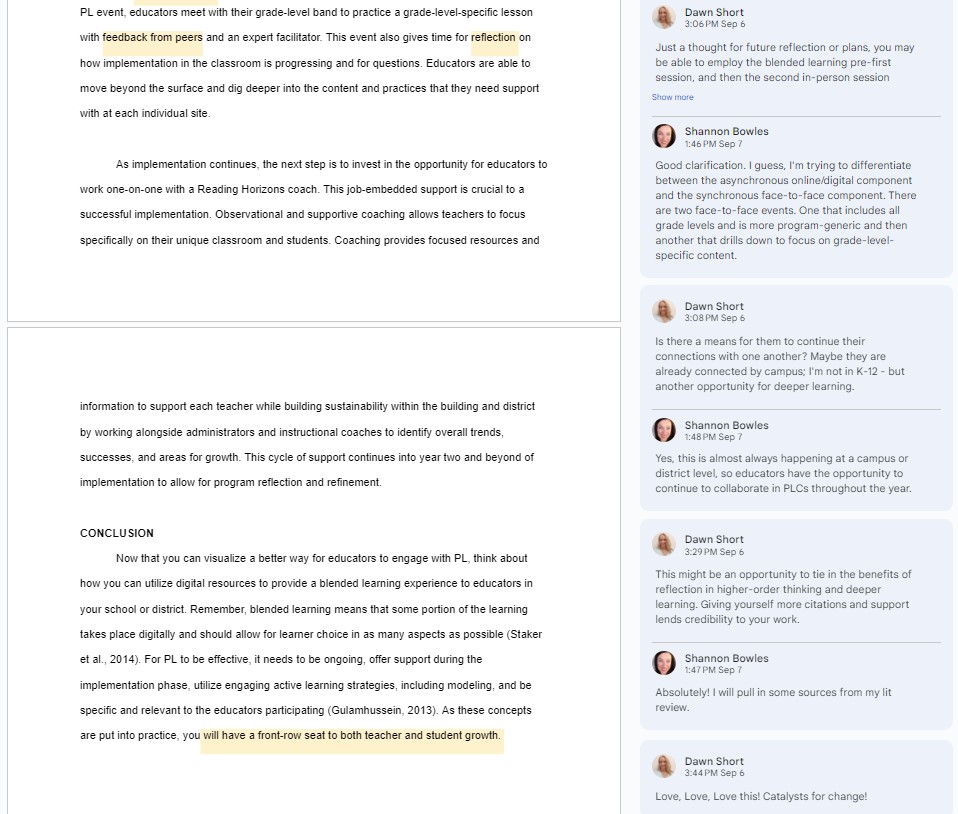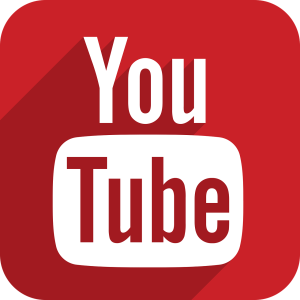Publishing Course
- Fall 2023
- Course Number: EDLD 5317
- Course Title: Resources for Digital Environments
Contributions to learning and learning community

I am giving myself a score of 95 out of 100
Crediting Core Group Member: Shannon Bowles and Chantilly Sweet
The remaining members of my core discussion group constantly changed based on discussion posting dates. I found it challenging to continue collaborating with the same core members (aside from Shannon) because I followed the course posting guidelines and deadlines.
I would like to give a proper thank you to all of those who regularly engaged with me in the course.
Discussion 1
Digital Tools in Digital Environments
- Responses to Angela Deschner, Chantilly Sweet, Jane Burnett, Shannon Bowles
- Responses from Angela Deschner
Discussion 2
Perusing and Sharing Publications
- Responses to Shannon Bowles, Chantilly Sweet, Argelia Perez Ramirez
- Responses from Shannon Bowles, Araceli Maria Lopez, Brenda Decuir, Angela Deschner
Discussion 3
Audio and Visual Digital Tools
- Responses to Shannon Bowles, Angela Deschner, Brenda Decuir, Roostynel Tovar, Chantilly Sweet
- Responses from Shannon Bowles
Discussion 4
- Responses to Shannon Bowles, Roostynel Tovar, Araceli Maria Lopez, Angela Deschner, Chantilly Sweet, Argelia Perez Ramirez
- Responses from Shannon Bowles

Peer Review Reflection
Shannon was an outstanding learning community member this session, and I was happy to provide feed-forward on her rough draft as she did for mine. Shannon provided valuable feedforward when concepts I sharing were unclear to the reader. What I found writing was that I had been working with the content and concepts so long that I was skipping details or failing to organize my thoughts in a logical sequence. Additionally, Shannon provided insight from their experiences during orientation, adding another layer to the audience’s perspective.
This learning community aspect is something that I will miss moving out of the ADL courses and into professional life. This must be why the ADL program encourages us to get involved in our professional learning organizations to continue this community-based learning beyond our time together. What a fantastic project to culminate the program by submitting our work for publication. Carefully crafting the ADL program, we can now continue the conversation with those in our professions.
Contributions

Key Contributions
From the very start of the session, I did my best to contribute to building a learning community and provided a positive and collaborative contribution. Throughout the course, I worked to meet all activity deadlines outlined by Dr. Still and kept up with the content in each module. I have posted by keeping up with the course schedule so that other learning community members have ample time to respond. I have also found that having time for feedback allowed me to improve assignments by their due dates. I complete and reflect upon all assigned course readings, videos, and resources and share additional sources discovered throughout my learning exploration and reflections on learning connections. I post when I will be available for support on long-term project days and before deadlines. I take feedback, ideas, and suggestions from the comments on shared documents and discussion board posts to improve my work and clarify my thoughts. I provide thoughtful feedback and support to my classmates and community members.
Supporting Contributions
I did my very best to take on leadership responsibility and always asked clarifying questions during class calls in hopes of helping myself and others. I participated in all activities and rewatched the class call recordings to reinforce learning opportunities discussed with classmates. I routinely check the discussion board for posts and updates to keep collaborations active and timely with posted deadlines and due dates. I actively seek additional sources and resources. This course specifically had some links that were no longer active, but I searched and reposted updated links for future reflection. I included citations of source materials and reflected on the lessons laid out for us throughout the course.
What Could Be Better

Several semesters ago, I began sharing a GroupMe for a collective of ADL learners. I had high hopes that the group would continue to intake new ADL students, thereby creating a long-term mentorship group with veteran and graduate ADL students continuing to learn while giving guidance and perspective to future cohorts. The hope was that learners who struggled to connect with a community in their coursework would find additional opportunities to connect with others with similar innovations or interests.

In the past, this has been such an active and collaborative group. Unfortunately, a large part of our collaborative membership graduated, and many left the group. Watching members leave the group was crushing, as I thought we would be lifelong learners together. Buying into the idea of the learning collective.
I tried to keep casting conversation starters and offered ongoing support to other learners, but the group was inactive this session. It seemed like no one reached out for help from different classes, and no one posted assignments for feedforward. I cannot help but wonder if it was due to the discussion board requirement for posts and comments.




What Worked
For me, especially in the absence of the collective, collaborative learning experience I had become accustomed to, blogging helped fill some of the reflection and exploration I would have been doing in learning community meetings. I have tried to take every lesson that the program designed for us to heart, and I believe Dr. Harapnuik wanted us to continue blogging throughout the program. Many do not maintain the practice, but it is a key component of higher-order thinking and metacognition. I firmly believe that this authentic learning environment provides us with a frame of reference for our learning opportunities.
Pub Crawl
That is a bit misleading… because when I say “pub crawl,” I mean crawling through the publication process. In my typical form, in the ADL Program, the first thing I…
Tell Others
Moving through the module 1-2 content in this my second to last ADL Program’s publishing course, I am encouraged to share my success stories. To consider what digital technology I…
Fire
Let me tell you. It is not exactly easy to focus on much of anything when there is a 3,000-acre wildfire burning a dozen miles away. I’m really trying to…
Find your Element
In the On Point interview, Sir Ken Robinson (2013) shares that as a young person, he found himself in special education classes and recognized people around him. “Finding what lies…
Digital Tools in Digital Environments
5317 Discussion 1 (1 of 2) Technology can certainly enhance learning, as we have discovered throughout our ADL learning journey. The fact that I can connect with learners from various…
Technology and College
Saving these EDUCAUSE Review sources for later reflection and review. Students: 9 Ways to Help Students Use Technology to Get the Most Out of College Microlearning: The “OG” or Hot…
Perusing and sharing Publications
5317 Discussion 1 (2 of 2) The ADL program has opened my eyes to exactly how much the landscape of learning has changed and how little the landscape of education has changed.…
Schank you very much
Well darn. How in the world am I just now learning about Roger Schank! A link was thrown into the publication assignment, and I was off exploring another rabbit trail.…
What to Write
Going through Dr. Harapnuik’s content and nearing the end of the ADL program makes many connections between the strategies and learning accomplished throughout this authentic learning environment. I cannot help…
Always timely, EDUCAUSE
While written with IT Leaders in mind, innovative educators and support staff can benefit from these 10 Calls to Action for the Future of Technology in Higher Ed. Reference Gonick,…
Digital Tools
5317 Discussion 2 The concept of data-driven analytics and decision-making appeals to me very much. As advisors, we often run from one fire/crisis to another. Stepping into a leadership role…
Preparing Pitch?
Desperation: Man! I cannot tell you how much I am missing my tribe. I have been posting and engaging with my classmates, but I’m failing and failing to find my…
Mind Blown!
My goodness gracious, my two main collaborators this semester just blew my mind with their statements about how helpful they find Google Slides. I always found them overwhelmingly blank because…
Ott, to check this out!
I cannot believe that I have not yet posted about the amazing commentary on significant learning opportunities outlined by Jim Ott.
Leftovers
Media Project leftovers Mannn, there’s so much to share. I definitely wanted to include a million quotes and clips in my media project. I will put them all here for…
Searching vs. Trying
Thanks to the ADL Program, I love that I am constantly observing my learning behaviors. I recently rearranged and connected multiple monitors. I still laugh at how much of this…
Engaging Media
5317 Discussion 3 In the ADL Program, we learn the importance of always focusing on learning. Technology, just for the sake of it, does not revolutionize education. We must be…
Purpose…
I am once again pulled to evaluate the purpose of my innovation. These final reflection stages of the ADL Program coursework really ask us to go back and evaluate our…







